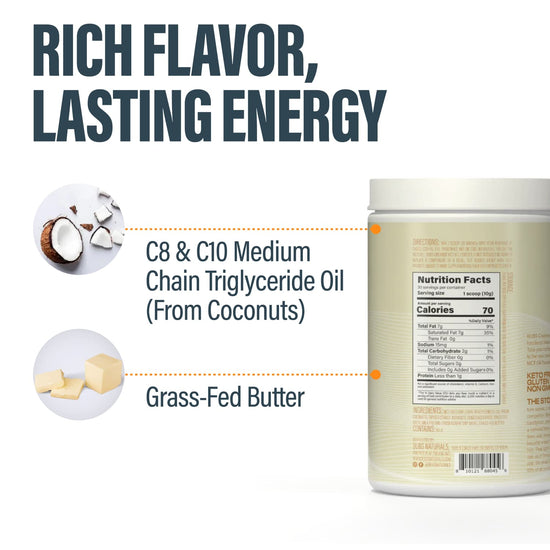Table of Contents
- Introduction
- What is MCT Oil?
- Why Add MCT Oil to Coffee?
- Do You Have to Blend MCT Oil in Coffee?
- Flavoring and Enhancing Your MCT Oil Coffee
- Additional Uses for MCT Oil
- Conclusion
- FAQ
Introduction
Have you ever thought about the way you start your day? For many of us, it begins with the comforting aroma of freshly brewed coffee, a ritual that dates back centuries. But what if we told you that you could supercharge your morning cup with a simple addition—MCT oil? This versatile ingredient has gained popularity among health enthusiasts, particularly those following ketogenic and low-carb diets. However, a common question arises: Do you have to blend MCT oil in coffee?
In this blog post, we’ll delve into the world of MCT oil, exploring its benefits, the science behind its use in coffee, and the best methods for incorporating it into your daily routine. We’ll also discuss how BUBS Naturals’ clean, functional supplements, including our MCT Oil Powder, can support your wellness journey. By the end of this article, you'll have a comprehensive understanding of MCT oil’s role in coffee and whether blending it is necessary for achieving the desired effects.
The significance of this topic lies in the growing trend of incorporating functional oils into our diets. As more people seek ways to enhance their health through their food choices, understanding how to optimize coffee with MCT oil can empower you to make informed decisions. We’ll cover the benefits of MCT oil, how to properly blend it into your coffee for optimal results, and tips to enhance flavor and nutrition without compromising your health goals.
Let’s embark on this journey together to discover how to elevate your daily coffee ritual with MCT oil.
What is MCT Oil?
Before we dive into the blending techniques, it's essential to understand what MCT oil is and why it has garnered such attention in health circles.
Definition and Composition
MCT stands for medium-chain triglycerides, a type of fat that is rapidly absorbed and metabolized by the body. Unlike long-chain triglycerides (LCTs), which are found in most fats and require more time and complex processes for digestion, MCTs are shorter and can be converted into energy more quickly. This means they can provide an immediate source of fuel for your body, making them particularly appealing for those engaging in physical activities or following a ketogenic diet.
Sources of MCTs
MCTs are naturally found in certain foods, with coconut oil being one of the richest sources, containing about 55% MCTs. Palm kernel oil also contains MCTs, but for supplementation purposes, concentrated MCT oil extracted from these sources is often preferred. At BUBS Naturals, our MCT Oil Powder is derived from clean, high-quality sources to ensure you receive the best benefits without any unnecessary additives.
Why Add MCT Oil to Coffee?
The addition of MCT oil to coffee has taken the wellness community by storm, and for good reason. Here are some compelling benefits:
1. Increased Energy Levels
MCTs are rapidly converted into ketones, which the body can use as a quick source of energy. This can be especially beneficial for those following a ketogenic diet or anyone looking for a sustained energy boost throughout the day. By adding MCT oil to your coffee, you can fuel your morning routine without the crash that often accompanies traditional sugary coffee beverages.
2. Enhanced Cognitive Function
Research suggests that MCTs may support cognitive health by providing an alternative energy source for the brain. Instead of relying solely on glucose, which can fluctuate based on dietary choices, ketones can help stabilize energy levels and enhance mental clarity. This makes MCT oil coffee a popular choice for those looking to improve focus and productivity.
3. Appetite Control and Weight Management
MCT oil has been shown to increase feelings of fullness, potentially helping to reduce overall calorie intake. By incorporating MCT oil into your morning coffee, you may find that you're less likely to indulge in unhealthy snacks before lunch. This can be particularly advantageous for those pursuing weight management or loss goals.
4. Supports Ketosis
For those following a ketogenic diet, MCT oil can help maintain ketosis, a metabolic state where the body burns fat for fuel instead of carbohydrates. By providing a rapid source of ketones, MCT oil can help you stay in ketosis, maximizing the benefits of your low-carb lifestyle.
5. Easy to Incorporate into Your Routine
Adding MCT oil to your coffee is a simple way to enhance your beverage without drastic changes to your diet. It seamlessly blends into your morning routine, allowing you to enjoy its benefits without additional preparation time.
Do You Have to Blend MCT Oil in Coffee?
Now that we’ve explored the benefits of MCT oil, let’s address the central question: Do you have to blend MCT oil in coffee?
The Importance of Blending
MCT oil is hydrophobic, meaning it does not naturally mix well with water-based liquids like coffee. If you simply add MCT oil to your cup of coffee and stir, the oil will likely float on top, leading to an unappealing drink. Blending is essential for creating a stable emulsion, which allows the MCT oil to disperse evenly throughout the coffee, enhancing both flavor and texture.
How to Blend MCT Oil into Coffee
To achieve the best results when adding MCT oil to your coffee, we recommend the following steps:
- Brew Your Coffee: Start by brewing your favorite coffee using your preferred method—whether it's a drip coffee maker, French press, or pour-over.
- Add MCT Oil: Pour 1 to 2 tablespoons of MCT oil into your brewed coffee. If you're new to MCT oil, start with 1 teaspoon and gradually increase your intake to assess your tolerance.
- Blend: Use a high-speed blender or an immersion blender to blend the coffee and MCT oil together. Blend for about 20 to 30 seconds until the mixture is creamy and frothy.
- Enjoy: Pour your blended coffee into your favorite mug and enjoy the rich, creamy texture that MCT oil adds to your drink.
Alternative Mixing Techniques
If you don’t have a blender handy, you can also use an electric frother or a milk frother to achieve a similar effect. While these methods may not create as smooth a texture as a high-speed blender, they can still help emulsify the oil into your coffee.
Flavoring and Enhancing Your MCT Oil Coffee
While MCT oil adds creaminess to your coffee, you might want to further enhance the flavor and nutritional profile. Here are some ideas:
1. Sweeteners
If you prefer a sweeter coffee, consider adding natural sweeteners that fit within your dietary goals. Options include:
- Stevia: A zero-calorie, low-carb sweetener.
- Monk Fruit Extract: Another natural, zero-calorie sweetener.
- Erythritol or Xylitol: Low-carb sugar alcohols that can add sweetness without the sugar.
2. Flavoring
To add a delightful twist to your MCT oil coffee, try incorporating flavors such as:
- Cinnamon: Known for its anti-inflammatory properties, cinnamon adds warmth and spice.
- Vanilla Extract: A few drops can enhance the overall flavor profile.
- Cocoa Powder: For a chocolatey delight, add unsweetened cocoa powder.
3. Protein Boost
For those looking to increase their protein intake, consider adding a scoop of collagen peptides from BUBS Naturals. Collagen is beneficial for skin, hair, and joint health, and it mixes well with coffee, enhancing both flavor and nutrition.
Additional Uses for MCT Oil
MCT oil isn’t just for coffee. Here are a few other ways to incorporate it into your diet:
- Smoothies: Add MCT oil to your morning smoothie for an energy boost.
- Salad Dressings: Create a simple vinaigrette by mixing MCT oil with vinegar and herbs.
- Baking: Incorporate MCT oil into recipes for baked goods to increase healthy fat content.
Conclusion
Incorporating MCT oil into your coffee can transform your morning routine into a powerhouse of energy, focus, and satiety. Blending MCT oil is crucial for achieving a smooth and creamy texture, ensuring that you reap the full benefits of this versatile ingredient. By exploring various flavor enhancements and other uses for MCT oil, you can create a personalized approach that fits seamlessly into your lifestyle.
At BUBS Naturals, we are dedicated to providing high-quality, clean supplements that support your active lifestyle. Our MCT Oil Powder is a fantastic choice for those looking to enhance their coffee, smoothies, and more. Shop our MCT Oil Powder today and experience the BUBS difference.
FAQ
1. Can I use MCT oil if I'm not on a keto diet?
Yes, MCT oil can be beneficial for anyone looking to boost energy levels, support cognitive function, and promote fullness, regardless of dietary preferences.
2. How much MCT oil should I add to my coffee?
Start with 1 teaspoon and gradually increase to 1-2 tablespoons, depending on your personal preference and tolerance.
3. Does MCT oil coffee break a fast?
While MCT oil contains calories, many people consider it acceptable during intermittent fasting as it does not significantly impact insulin levels.
4. Is blending MCT oil necessary?
Yes, blending helps emulsify the oil into the coffee, creating a smooth texture and enhancing flavor.
5. Can I use MCT oil for cooking?
MCT oil has a low smoke point, so it is not ideal for high-heat cooking. Instead, use it in salad dressings or smoothies.
By integrating MCT oil into our daily routines, we can embrace a lifestyle that supports wellness, adventure, and purpose—hallmarks of the BUBS Naturals mission. Together, let’s elevate our health and enjoy the journey!
Written by:
Bubs Naturals

Butter MCT Oil Creamer
BUBS Butter MCT Oil Creamer (formerly Halo Creamer): Scientifically-Backed Brain and Body Fuel
BUBS Butter MCT Oil Creamer is your go-to for clean, fast-acting energy and focus, no crash included. It blends creamy grass-fed butter with fast-acting MCT oil powder (C8 and C10) to kickstart your day and keep you sharp. The MCTs go straight to work, giving your brain a quick boost while the grass-fed butter supports digestion and gut health.
Together, they help curb cravings, keep you feeling full longer, and support steady energy throughout the day—perfect for fueling your mornings or powering through the afternoon slump.
Starts at $36.00
Shop

